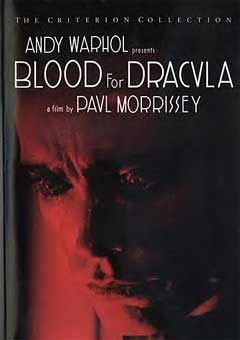 BLOOD
FOR DRACULA (1974)
BLOOD
FOR DRACULA (1974)Director: Paul Morrisey
The Criterion Collection
 BLOOD
FOR DRACULA (1974)
BLOOD
FOR DRACULA (1974)The Criterion Collection has long enjoyed a reputation for the highest quality in their transfers as well as their splendid selection of film classics from around the world. With this in mind, it must seem odd to see titles like FIEND WITHOUT A FACE (1958) and THE BLOB (1958). Most surprising was Criterion's inclusion of Andy Warhol's two excursions into the horror genre during a production deal made in Italy with his in-house director, Paul Morrissey. The assistant director of this production was none other than the late legendary Antonio Margheriti who is more than likely responsible for the more coherent aspects of the production although both Kier and Dallesandro place his contributions at a minimum. The success worldwide of FLESH FOR FRANKENSTEIN, which had the novelty of being in 3-D, inevitably made a Dracula film the next step in continuing the combination of black comedy and excessive, outrageous gore and sexuality.
The choice of BLOOD FOR DRACULA
is a good one for a number of reasons. First, it is perhaps the most unusual
and avant-garde presentation of the Dracula legend. The casting of Udo Kier
as Dracula is inspired for his inherent sense of camp and pathos which is the
key to his performance. The other cast members are blissfully at odds with his
Germanic presence and charisma. Morrissey utilizes his own superstar, Joe Dallesandro,
to great effect as the Marxist handyman who deflowers all Dracula's potential
brides. Dallesandro has a movie star quality that served him well as did his
muscular physique which made him an international sex symbol for both gay men
and women.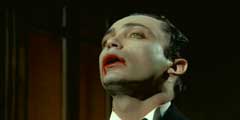
The production values are first class -- the Italian locales are idyllic and the castle (in Frascati) is quite real and the art direction is breathtaking. Interiors were shot at Cinecitta. Camera Operator was Ubaldo Terzano, a Mario Bava mainstay for such classics as BLACK SUNDAY (Terzano went on to be Cinematographer for The Maestro's BLACK SABBATH, BLOOD AND BLACK LACE and others; he was also Camera Operator for Dario Argento's DEEP RED). The locations employed on this film were also utilized previously for FLESH FOR FRANKENSTEIN as both films were shot back to back.
The soundtrack by Claudio Gizzi may be one of the most haunting and unforgettable ever done for a Dracula film; the score is a classical fusion of piano, wind instruments and a horn all evoking melancholy, lost love and the romance of a bygone era. The score seems at a direct counterpoint to the story unfolding on the screen. This score appeared on CD in 1993 (doubled with the same composer's score for FLESH FOR FRANKENSTEIN) by RCA/BMG Ariola S.p.A. This CD is still available in many places and is well worth obtaining.
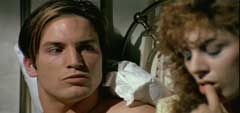 What
was perhaps off-putting for mainstream audiences of its time was the overabundance
of gore and violence [meant as a send-up rather than a serious aspect of the
film]. The demise of Dracula was obviously an inspiration for the Monty Python
writers later on. The sex is far from pornographic and makes points plotwise
as Dallesandro's handyman keeps advising the young ladies about the inevitable
collapse of the decadent capitalist world that their parents hold sacred.
What
was perhaps off-putting for mainstream audiences of its time was the overabundance
of gore and violence [meant as a send-up rather than a serious aspect of the
film]. The demise of Dracula was obviously an inspiration for the Monty Python
writers later on. The sex is far from pornographic and makes points plotwise
as Dallesandro's handyman keeps advising the young ladies about the inevitable
collapse of the decadent capitalist world that their parents hold sacred.
The supporting cast includes two
world-famous directors, Vittorio De Sica and Roman Polanski. De Sica gives a
charming performance as the bankrupt father with an estate in ruin and four
daughters who pay no attention to his plight. Polanski has a clever cameo as
a disgruntled villager in a tavern with a knack for playing with knives. As
Dracula's manservant Anton, Arno Juerging is very funny in the way he adjusts
to Udo Kier's accent and demeanor. It is sad to note that at the film's completion
this talented actor took his own life in despair over the death of his mother,
to whom he was severely attached.
he was severely attached.
The Dracula legend is given some new life in this black comedy as the vampire is more than vulnerable; he is, in fact, an invalid, at times using a wheelchair to get about and is probably the first screen Dracula to vomit on camera more than once. This prince of the undead may drink only the blood of virgins ("were-gins") but finding one in Northern Italy proves to be impossible! Unclean blood (that of non-virgins) causes nausea and inevitably our fanged fiend must expel it from his system or die! Also, this vampire can walk about in daylight and crosses bear him no discomfort.
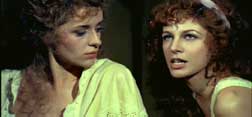 Udo
Kier, in an interview with film historian David Del Valle noted: "I really
did starve myself. I did not eat. I had salad or steak sometimes and that's
why I'm sitting in a wheelchair in DRACULA: because I really couldn't stand
up anymore. I was really weak -- which I liked."
Udo
Kier, in an interview with film historian David Del Valle noted: "I really
did starve myself. I did not eat. I had salad or steak sometimes and that's
why I'm sitting in a wheelchair in DRACULA: because I really couldn't stand
up anymore. I was really weak -- which I liked."
This is of course a Warhol film
in name only as Udo Kier recalls seeing the reclusive artist only at the wrap
party and the premiere, thus leaving Morrissey as the sole auteur of this production.
The script has many superb touches beginning with the opening credits as Dracula
paints his face to look more human and his very gray hair black to remain youthful.
The placing of his sister in her coffin as she is too weak from lack of blood
to leave the Romanian castle as her brother begins his journey west to find
virgin blood to save the Dracula line from extinction is also memorable.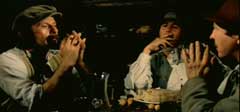
Polanski's cameo happened quite by accident, according to Kier. "Polanski agreed to appear in a cameo because I went away. I had promised a friend of mine, a German director that I would appear in his film. And I kept my promise. So I went away, for one day, and they didn't know what to shoot without me. That's why they shot the scene with my assistant [Arno Juerging] and Polanski. It was not only Polanski in that scene but also Gerard Brach [Polanski's screenwriter], the producer [Andrew Braunsberger] and writer, and all of Polanski's friends. It was a very important day, actually. I went to Austria, played a poet in my friend's film, and came back to shoot."
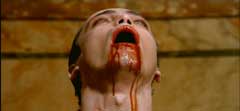 Kier
also spoke of the locations to David Del Valle. When asked if the locations
were famous villas, he remarked, "Well, FRANKENTEIN was more or less all
done at Cinecitta, in the studio. DRACULA was done in an actual castle in Frascati,
where the famous wine comes from. And it was fabulous because this castle actually
had its own story. The owner of the castle was in a madhouse, and his family
was renting it out to film crews to make money so they could pay his hospital
bills. It was very funny; at one point there were two different film crews working
in the same building. Once I went out of a door, dressed as Dracula, and I came
out through a secret door, and found myself in the middle of another set, with
the cameras running! So I ran in, said "I'm sorry," and I got out!
Unfortunately they were not clever enough to keep my little cameo in their film!"
Kier
also spoke of the locations to David Del Valle. When asked if the locations
were famous villas, he remarked, "Well, FRANKENTEIN was more or less all
done at Cinecitta, in the studio. DRACULA was done in an actual castle in Frascati,
where the famous wine comes from. And it was fabulous because this castle actually
had its own story. The owner of the castle was in a madhouse, and his family
was renting it out to film crews to make money so they could pay his hospital
bills. It was very funny; at one point there were two different film crews working
in the same building. Once I went out of a door, dressed as Dracula, and I came
out through a secret door, and found myself in the middle of another set, with
the cameras running! So I ran in, said "I'm sorry," and I got out!
Unfortunately they were not clever enough to keep my little cameo in their film!"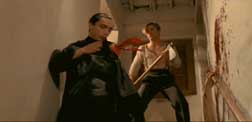
When asked if Warhol ever came on the set, Kier replied, "Yeah, for publicity. Andy came and we had pictures taken for Vogue... we also did a lot of newspaper publicity when Andy came." The Warhol name was strictly lent for commercial purposes, though.
There are 26 chapter stops on this splendid, must-have disc plus audio commentaries by Maurice Yakowar, Udo Kier and Paul Morrissey. This is one stellar disc that should be in everyone's collection. BLOOD FOR DRACULA is also one of the great horror films of the 70s, on a par with THE EXORCIST (1973), THE OMEN (1976) and SUSPIRIA (1977).
The Criterion Collection is certainly the finest distributor of films, period. One hopes they will continue to release titles such as these with many great extras. BLOOD FOR DRACULA is a must for every serious collector -- a defining moment for Udo Kier, one of the highest peaks in a decade very sparse for great horror film, and a classic in every regard. A masterpiece! (Christopher Dietrich)